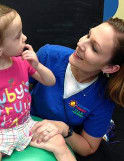

Biting? Oh my!
Toddlers bite for many different reasons. Toddlers who bite are not bad children. Developmentally, toddlers are at a common age for biting. Some of the reasons toddlers may bite include:
- Communication
- Oral sensory seeking
- Anxiety/nervousness/feeling overwhelmed
It is important to observe the child who is biting and try to determine the cause for a particular biting pattern.
As with ANY challenging behavior, it does not work to simply remove the inappropriate behavior. Success will come from replacing the less desirable behavior with a positive, more desirable behavior.
If the reason for biting is lack of communication, some appropriate replacement behaviors include:
- Teach the child simple signs or words to communicate needs. Children can begin to learn simple signs as early as 8 months old. Appropriate signs/words can include “please,” “more,” “all done.”
- Attempt to watch the child and anticipate his/her needs, especially at times of high anxiety.
- Use picture schedules to help communicate the schedule for the day, as well as allow the child to communicate with adults by handing the pictures to an adult.
Children at this age are naturally oral sensory seeking. It is important to provide more appropriate outlets for obtaining this necessary sensory input, rather than biting. With the following suggestions, it is important to take into consideration the age and developmental level of the child in order to choose the most appropriate techniques.
- Provide sucking input (which is calming) including the use of pacifiers, sippy cups, teethers, sucking through narrow straws, suckers, etc.
- Provide temperature input in the form of cold/frozen teethers, frozen wet wash cloths, drinking ice water, Popsicles, etc.
- Provide taste input in the form of strong flavors including sour fruit/juices, sour candy, salsa, spicy sausage, etc.
- Provide textural input including vibrating toys, teethers of various textures, chewing on toothbrushes, chewing on blankets/scarves of various textures, etc.
It is important to carefully monitor the child when providing any sensory input in order to make sure that the child is enjoying the additional sensory input, as opposed to it being overwhelming and noxious to the child.
If the child is biting due to anxiety, the following strategies may be helpful.
- In a group setting or while lining up, place the child in the front/back/edge of the group where they are less likely to get bumped by other children.
- Provide some one-on-one time with an adult at times of high anxiety, when the child is more likely to bite.
- Separate a child who bites from the child who frequently gets bitten.
- Work to identify and treat the child’s anxiety. Watch the child for signs of anxiety. If the child is becoming overwhelmed, look for ways to temporarily remove the child from the noxious stimuli and into a calmer environment. In addition, a deep bear hug and some reassurance can also go a long way to help with decreasing a child’s anxiety.
If no success is seen with the above techniques, it may be helpful to seek out individual guidance from your pediatrician, ABA therapist, occupational therapist, speech therapist, or psychologist. They can be helpful in identifying causes for biting in the individual child and can help create customized solutions.
About the author
Melissa Foster is a Nationally Board Certified Occupational  Therapist who received her Masters in Occupational Therapy from University of Central Arkansas in 2004. She came to Children’s Therapy T.E.A.M. in 2013 with a wealth of treatment experience in settings that range from clinical experience in Northwest Arkansas (NWA) to Kansas to New York. Her primary interests are treatment of children on the Autism Spectrum, treatment of children with ADHD and treatment of children with sensory processing and behavioral disorders. Melissa is an active public speaker in the NWA community on topics related to Autism and Sensory Processing Disorder. She has authored several resource materials for parents on topics such as picky eating and toys to promote development. Her blogs address topics of interest to parents and have become a popular resource for families. Melissa loves spending time with her husband and their two children. On warm summer days she enjoys sitting on her patio with a good book and a glass of iced tea.
Therapist who received her Masters in Occupational Therapy from University of Central Arkansas in 2004. She came to Children’s Therapy T.E.A.M. in 2013 with a wealth of treatment experience in settings that range from clinical experience in Northwest Arkansas (NWA) to Kansas to New York. Her primary interests are treatment of children on the Autism Spectrum, treatment of children with ADHD and treatment of children with sensory processing and behavioral disorders. Melissa is an active public speaker in the NWA community on topics related to Autism and Sensory Processing Disorder. She has authored several resource materials for parents on topics such as picky eating and toys to promote development. Her blogs address topics of interest to parents and have become a popular resource for families. Melissa loves spending time with her husband and their two children. On warm summer days she enjoys sitting on her patio with a good book and a glass of iced tea.
last updated January 25, 2021
